During my vacation in February I tried several kinds of steamed buns in Taipei. Since then I’ve developed an interest in Chinese steamed buns. These hot, soft and airy buns are just too good whether stuffed or plain! When we order steamed buns at the dim sum restaurant, my kids (and myself) always get very excited and would exclaim “wahhh…” the moment the lid of the bamboo steamer is opened.
二月假期時EC曾在台北嚐過不同的饅頭,自始便對中式飽點產生了興趣。這些熱騰騰又鬆又軟的饅頭包子,不管內裡有沒有餡料勻十分好吃。平時與家人上酒樓飲茶時,每次包子端上枱蒸籠蓋打開時小孩們(還有EC)也會興奮地「嘩!」一聲叫出來。
When I was back to Toronto I started experimenting with the dough. I relied on my instinct and previous experience on bread making and made my first batch of steamed buns. And crap… it was a nasty disaster! Most of the buns looked like an old man with wrinkled skin and bumps all over (thinking back I believe I have over proofed my dough. Also the water was dripping back on the buns during steaming). Being indignant, I started to look up chinese dim sum cookbooks and search on the internet for help. An interesting finding was that many recipes use both baking powder and yeast. Well, wasn’t the dough puffed up by the yeast already? Why was baking powder ever required? I was puzzled and confused as a lot of the recipes and blogs I read gave no explanation to the usage of baking powder. Later that week I finally found the answer in Mrs. Jiang Xianzhu’s cookbook.
返回多倫多後EC便開始嘗試弄中式發麵。初時依賴做麵包的經驗和直覺製作出第一批饅頭,怎料效果強差人意,饅頭就像是老人家似的,表面充滿皺紋兼凹凸不平(現在回想應該是發酵過度了,另外也有倒汗水滴在饅頭上)。不服氣之下便於點心食譜書及網上找資料尋求協助,細看之下發現很多中式發麵食譜都並用了酵母及泡打粉哦!EC看罷
不禁心生疑問,麵糰由酵母發酵不是已足夠麼?為什麼還要使用泡打粉呢?書本跟網上食譜並沒有解釋使用泡打粉的原因啊!真的百思不得其解,後來在江獻珠女士的著作中終於找到答案。
In the book Chinese Dim Sum 2 Mrs. Jiang wrote that after the initial rise the dough rises rapidly and contains lots of air bubbles. When contacted with cool air upon steaming, the bread will collapse easily. Kneading baking powder into the dough after the initial rise helps stabilize the dough. I don’t want to add baking powder to my dough (I’ve seen many recipes without it anyways). After some trial and error I have come up with my own way. In order to prevent the dough from having too much air bubbles, the first rise is omitted (which will speed things up too). After kneading is completed I move directly to divide and shape the dough after a short resting period. I also make sure my dough is not fully proofed as in bread making (in which the indentation remains when the side of the dough is lightly touched with fingertip). The dough will be ready for steaming if it is about 1.5 times its original size and when pressed, the indentation will spring back very slowly. Last thing is to start off with cold water when steaming. This will allow the dough to rise slowly and steadily. So far these combined strategies all result in soft and puffy buns with a very smooth outer skin.
在<珠璣小館:中國點心2>中,江女士提及酵母會令麵糰迅速膨脹產生大量氣泡,蒸起後成品遇冷收縮便很容易塌陷,而在第一次發酵後加進泡打粉則有穩定麵糰的作用。反正有很多不含泡打粉的食譜,EC也不想另加泡打粉。試驗了幾次之後EC總算找到自己的方法:為了避免麵糰產生大量氣泡,基礎發酵可省略(這樣做反而更簡便),麵糰搓好後稍為醒發已可直接分割及造型。此外,最後發酵過程也不能像烘焙麵包般達到完成階段(即用手指輕壓麵糰後凹陷處不會回彈),只需發酵至約1.5倍大,按下時凹陷處會慢慢回彈已是很足夠了。最後就是從冷水開始蒸,讓麵糰可慢慢的均勻的發起來。結合了以上幾個點子,EC每次都蒸出鬆軟並表面光滑的饅頭。
I am providing two steaming methods below: one with stovetop and the other with steam oven. I prefer my steam oven simply because of efficiency. After filing the water tank I could proof then steam my buns with the touch of a button. The only downside is that the oven space is limited whereas bamboo or stainless steel steamers are stackable.
蒸法方面,EC會分別提供使用爐頭與蒸焗爐兩種做法。相比之下EC較喜愛蒸焗爐,因為只要水箱注滿水再按鍵後即可進行發酵並選擇以蒸氣烹調,實在方便得很。只是蒸焗爐容量有限,不像竹或不銹鋼蒸籠般可以一次蒸很多層。

Bear-Shaped Chinese Steamed Buns (Mantou)
小熊造型饅頭
Makes 5
五個份量
Ingredients
144 g all purpose flour
90 – 100 g milk, room temperature
15 g granulated sugar (I used organic cane sugar)
1/2 tsp active dry yeast
7 g grapeseed oil
For Coloring
6 g (1 Tbsp) dutch-processed cocoa powder
Black food color gel or bamboo charcoal powder as needed
材料
中筋麵粉 144克
牛奶(室溫) 90至100克
細砂糖 15克 (EC用有機蔗糖)
活性乾酵母 半茶匙
葡萄籽油 7克
調色用
鹼化可可粉 6克(1湯匙)
竹碳粉或黑色食用色膏 適量
Directions 做法
In a large mixing bowl, whisk together the flour, sugar and yeast (according to King Arthur Flour, it is no longer necessary to dissolve active dry yeast in warm water before using due to the much gentler modern manufacturing process). Make a well in the center then pour in the milk and oil. Stir with a pair of chopsticks or a spatula until a shaggy dough forms. Cover with plastic wrap and set aside for 10 minutes. During this resting period autolyse will happen. Flour is hydrated and the dough will be less sticky to handle. Kneading time will become shorter.
麵粉、糖、酵母放入攪拌盆中拌勻(King Arthur Flour提及由於現代生產酵母技術已更溫和,因此活性乾酵母現巳不需溶解活化已可直接使用),中開一穴加入牛奶和油,用筷子或膠刮拌至剛成糰,蓋上保鮮紙靜置10分鐘,此時麵糰會產生水合作用,麵粉吸水後揉搓時麵糰會變得較不黏手,時間也會縮短。
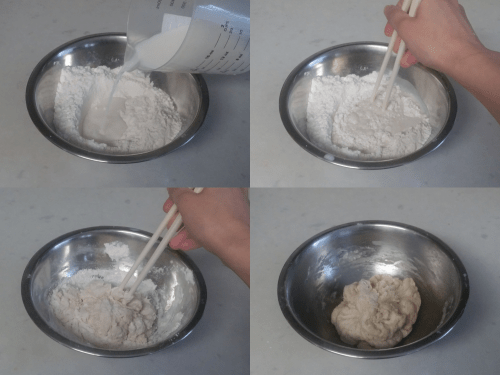
Scrape dough onto a floured working surface and knead until dough is smooth. Reserve 5 g of dough as the white dough. Knead cocoa powder into the remaining dough until it is smooth and elastic. Cut out 5 g and make the black dough by kneading in bamboo charcoal powder or black food coloring (it is easier to turn dough into black from brown than from white). Cover all doughs with plastic wrap and rest for 5 minutes.
刮出麵糰在已洒了粉的工作枱上揉搓至平滑,先分出5克蓋好留作白色麵糰,餘下麵糰加入可可粉作啡色麵糰,繼續揉搓至光滑有彈性,再分出5克加入少量竹碳粉或黑色色素搓匀成黑色麵糰(從啡色轉成黑色比從白色轉成黑色容易),蓋好所有麵糰防乾後休息5分鐘。
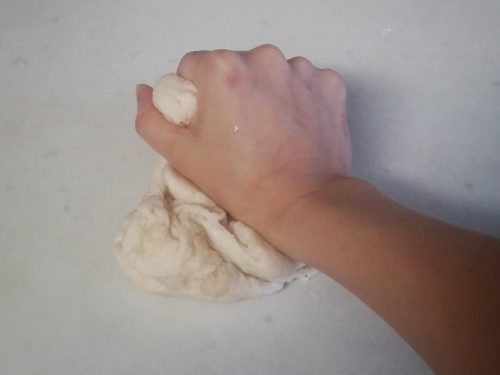
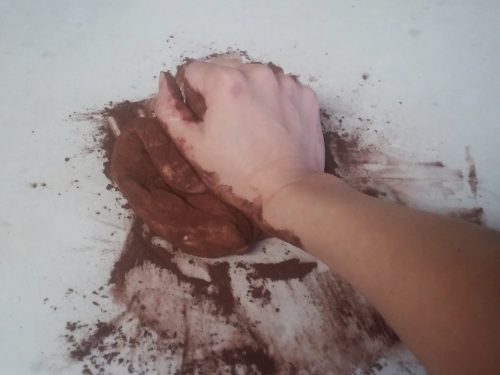
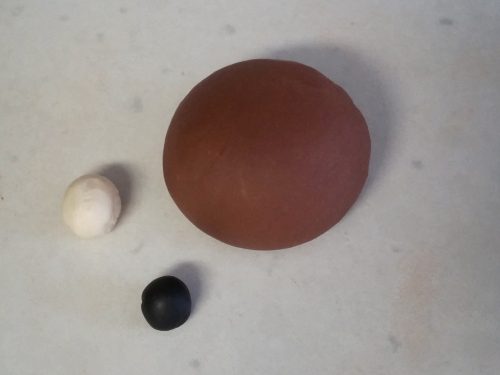
Divide brown dough into 5 45-g and 10 3-g pieces. Divide white dough into 5 equal pieces.
啡色麵糰分割成45克麵糰5份及3克麵糰10份,白色麵糰也分成5等分。

To form the bear’s head, shape the bigger brown dough into a ball and place with seam side down on a piece of parchment paper square. To make the ears, roll two smaller brown doughs into a sausage. Fold each log in half then flatten the ends. Slide the flattened side under the bear’s head and attach with some water.
把大的啡色麵糰滾圓後收口朝下放在饅頭紙或方形牛油紙上作小熊頭部,把2個小的啡色麵糰搓成粗條,各把兩端對摺做成耳朵,按扁末段後掃水把扁的一方貼在頭部底下。
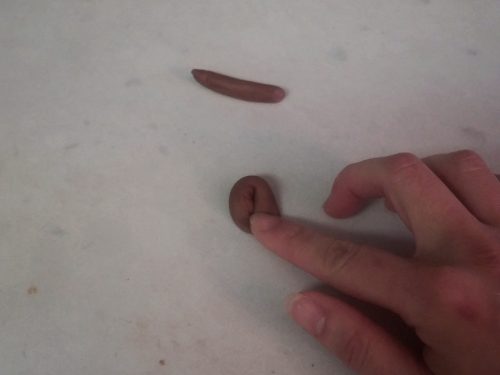
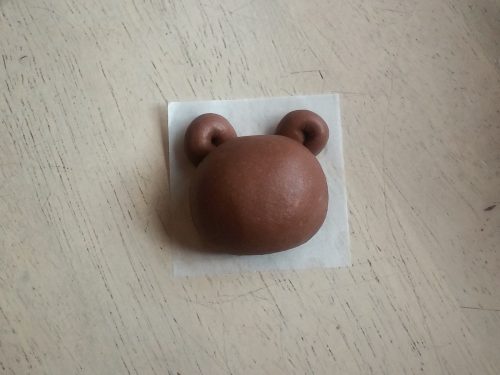
Shape the white dough into an olive and flatten to an oval with fingers. Attach the disc on the middle of the bear’s head with some water. Roll black dough into balls of various size to make the nose and eyes. Take a small piece of black dough and roll into string and make the mouth. Attach all shapes to the head with water.
取白色麵糰搓成橄欖形後按扁成橢圓片,用水貼在頭部中央,取少量黑色麵糰分别做成大小圓球作鼻子及眼睛,再取少許麵糰搓成條狀做咀巴,用水貼上。

Arrange all shaped doughs onto the steaming plate, spacing them out evenly.
所有做好的麵糰排放在蒸片上,麵糰間要留空間。
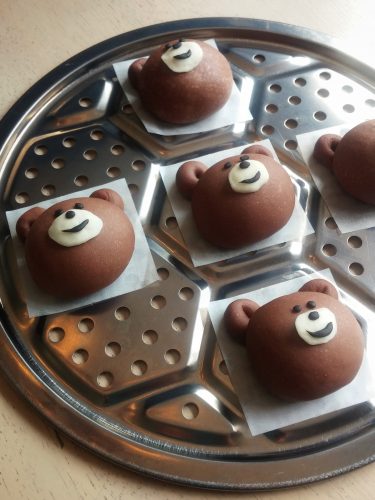
Steaming on the stove top: place steaming plate into the pot then fIll with some warm water. Cover with lid then let rest for 30 minutes until dough is puffy (about 1.5 times its original size). Bring water to a boil then reduce to medium and steam for 15 minutes. Steaming with steam oven: place steaming plate into the steam oven. Fill water tank with water and use the proofing function to proof the buns for 30 minutes until puffy (about 1.5 times its original size). Steam at 210℉/100℃ for 18 minutes.
使用爐頭:把蒸片放進已注暖水的蒸鍋中,蓋上鍋蓋發酵30分鐘至1.5倍大,從冷水開始蒸,水滾後轉中火蒸約15分鐘;使用蒸焗爐:把蒸片放進水箱已注水的蒸焗爐內,以發酵功能發酵30分鐘至麵糰1.5倍大,之後以210℉/100℃蒸18分鐘。


Turn off heat or switch off oven. Let rest for 5 minutes before removing the buns (this will prevent dramatic temperature change which causes shrinkage and wrinkled skin). Serve hot or warm.
關火/爐待5分鐘後才取出(這樣可避免極端溫差造成饅頭縮水或皺皮),趁熱或暖吃。

These were another styles that I made. I was trying to make one of the Line Friends characters but it looked more like a frowning bear. My younger son referred them as “the bread with a sad face”.
這些饅頭依Line Friends的小熊造型而作,可是小熊好像很不快樂似的,小兒子稱它們為「sad face 包包」。
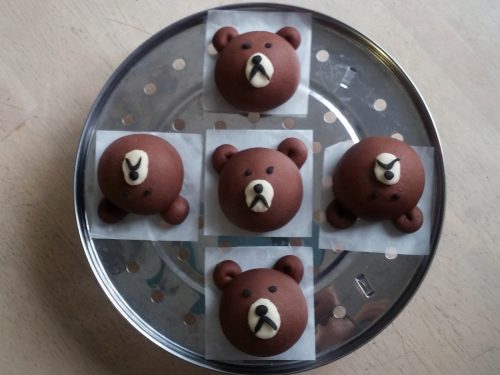


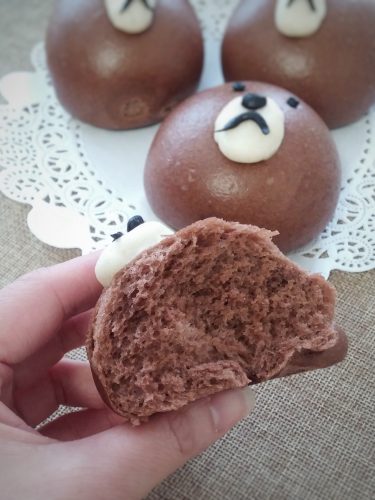
If you want to republish this recipe, please link back to this post.
版權所有,如需引用,請註明出處
EC Bakes 小意思 Facebook 專頁 www.facebook.com/ECBakes
© Copyright 2017 ecbakes.com
Leave a comment